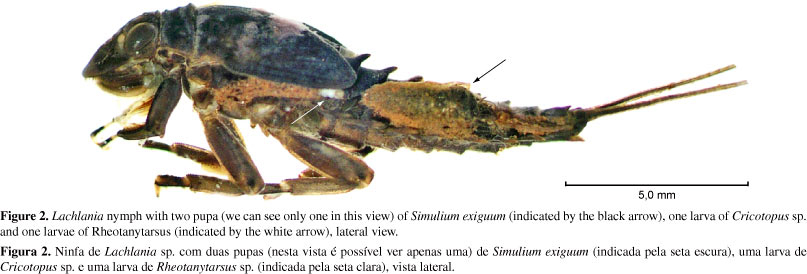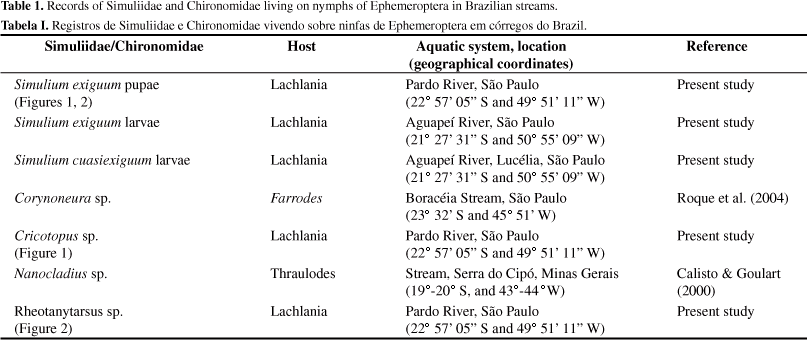Abstracts
We report cases of Simuliidae and Chironomidae living on Lachlania nymphs (Ephemeroptera). This is the first record of these associations in South America. Simulium exiguum (pupae and larvae), Simulium cuasiexiguum (larvae), Cricotopus sp. (larva) and Rheotanytarsus sp. (larva) were found associated with Lachlania nymphs. We believe that all of these associations can be classified as opportunistic (or casual) attachment.
aquatic insects; neotropical region; association; black fly; mayfly
Este é o primeiro registro de associações entre imaturos de Simuliidae e Chironomidae vivendo sobre ninfas do gênero Lachlania (Ephemeroptera) na América do Sul. Simulium exiguum (pupas e larvas), Simulium cuasiexiguum (larvas), Cricotopus sp. (larva) and Rheotanytarsus sp. (larva) foram coletadas vivendo sobre/aderidas a ninfas de Lachlania. Apesar de existirem algumas espécies que vivem, obrigatoriamente, sobre ninfas e larvas de outros insetos aquáticos, no presente estudo estas associações podem ser classificadas como casuais.
insetos aquáticos; região neotropical; associação; borrachudo; foresia
SHORT COMMUNICATIONS
First report of Simuliidae and Chironomidae (Diptera) living on nymphs of Lachlania Hagen (Ephemeroptera: Oligoneuriidae) in South America
Primeiro registro Simuliidae e Chironomidae (Diptera) vivendo sobre ninfas de Lachlania Hagen (Ephemeroptera: Oligoneuriidae) na América do Sul
Mateus PepinelliI, 1 1 Corresponding author: Mateus Pepinelli, e-mail: mateuspepi@yahoo.com.br ; Tadeu SiqueiraII; Frederico Falcão SallesIII; Eduardo Mitio ShimboriII
ILaboratório de Entomologia Aquática, Departamento de Biologia, Faculdade de Filosofia, Ciências e Letras de Ribeirão Preto, Universidade de São Paulo - USP, Av. Bandeirantes, 3900, Monte Alegre, CEP 14040-901, Ribeirão Preto, SP, Brazil
IIPrograma de Pós-Graduação em Ecologia e Recursos Naturais, Universidade Federal de São Carlos - UFSCar, Rod. Washington Luís, Km 235, CEP 13656-905, São Carlos, SP, Brazil
IIIDepartamento de Ciências da Saúde, Biológicas e Agrárias, Centro Universitário do Norte do Espírito Santo, Universidade Federal do Espírito Santo - UFES, Rua Humberto de Almeida Franklin, 25, Universitário, CEP 29933-480, São Mateus, ES, Brazil
ABSTRACT
We report cases of Simuliidae and Chironomidae living on Lachlania nymphs (Ephemeroptera). This is the first record of these associations in South America. Simulium exiguum (pupae and larvae), Simulium cuasiexiguum (larvae), Cricotopus sp. (larva) and Rheotanytarsus sp. (larva) were found associated with Lachlania nymphs. We believe that all of these associations can be classified as opportunistic (or casual) attachment.
Keywords: aquatic insects, neotropical region, association, black fly, mayfly.
RESUMO
Este é o primeiro registro de associações entre imaturos de Simuliidae e Chironomidae vivendo sobre ninfas do gênero Lachlania (Ephemeroptera) na América do Sul. Simulium exiguum (pupas e larvas), Simulium cuasiexiguum (larvas), Cricotopus sp. (larva) and Rheotanytarsus sp. (larva) foram coletadas vivendo sobre/aderidas a ninfas de Lachlania. Apesar de existirem algumas espécies que vivem, obrigatoriamente, sobre ninfas e larvas de outros insetos aquáticos, no presente estudo estas associações podem ser classificadas como casuais.
Palavras-chave: insetos aquáticos, região neotropical, associação, borrachudo, foresia.
Introduction
Associations of aquatic insects, especially Simuliidae and Chironomidae, with nymphs of mayflies (Ephemeroptera) have been documented by several authors (e.g. Corbet 1960, Crosskey 1965, 1990, Disney 1971a, 1971b, 1973, De Moor 1999, Callisto & Goulart 2000, Caldwell & Wiersema 2002, Roque et al. 2004). Regarding Simuliidae, two types of association are reported: obligate phoresy and opportunistic (or casual) attachment. Obligate phoresy has been reported in 28 species of Simuliidae living on Ephemeroptera nymphs or decapod crustaceans. The larvae of phoretic species exhibit adaptive modifications to live on the bodies of those arthropods (Crosskey 1990). In contrast, opportunistic attachment occurs as the product of chance encounters (Crosskey 1990). Despite the few records of larvae and pupae of non-phoretic black flies living on bodies of other animals, in most cases the association between black fly species and mayfly nymphs is described as obligate phoresy. Moreover, all of these records are restricted to Africa and Asia (Crosskey 1990).
Recently, Roque et al. (2004) published a review on inter-actions between Chironomidae and other aquatic animals in Brazil. They present an updated list of records of chironomids living on aquatic organisms in Brazil and discuss the difficulties of studying chironomid-host interactions. Despite this recent effort in investigating these interactions, there are only two records of chironomid larvae living on nymphs of mayflies in Brazil, both of the family Leptophlebiidae (Callisto & Goulart 2000, Roque et al. 2004). To our knowledge, there are no records from Brazil or even South America on interactions or associations between Simuliidae and Ephemeroptera.
Material and Methods
The nymphs of Lachlania were collected at the Pardo and Aguapeí Rivers, both in the State of São Paulo (Southeastern Brazil) during a field survey in April and August of 2004. The material was deposited in the Museu de Zoologia, Universidade de São Paulo.
Aquatic insects were hand collected directly from the substrate (stems, roots and leaves).
Results and Discussion
In this paper, we report the occurrence of larvae and pupae of Simuliidae and larvae of Chironomidae living on mayfly nymphs of the genus Lachlania Hagen (Oligoneuriidae) in Brazil.
Four larvae and two pupae of Simuliidae and two larvae of Chironomidae living on Lachlania nymphs were collected (Table 1). All cases of association between black flies and nymphs of Lachlania were observed in the field, and specimens were preserved in separate vials. Since black fly larvae dislodge easily from the body of the nymphs when fixed and transported, we present a photographic record (Figures 1 and 2) of Lachlania nymphs that were carrying pupae of Simulium exiguum Roubaud and two Chironomidae larvae. The larva and pupa of Simulium exiguum and Simulium cuasiexiguum Shelley, Luna Dias, Maia Herzog & Lowry usually live on submerged deciduous leaves and roots, and on leaves of the streamside vegetation (Pepinelli et al. 2006).
Although specimens in this study were not collected quantitatively, there is evidence to suggest that the association between mayflies and simuliids occurs at relatively low frequencies. We collected 27 Lachlania nymphs in the Pardo River and only one had a pair of Simulium exiguum pupae attached (Figures 1, 2). In contrast, more than 100 larvae and pupae of the same species of black fly were found attached to submerged stems, roots and leaves at the same site. Similarly, we collected 19 Lachlania nymphs in the Aguapeí River and only two of them contained larvae of black flies attached to their bodies. Once again, large numbers (>200) of simuliid larvae and pupae were found attached to submerged stems and roots at the same site.
Phoretic associations of black fly species recorded in the literature indicate that there are adaptive modifications of morphological structures which differ conspicuously from those found in typical non-phoretic species that live on vegetal or mineral substrata (Crosskey 1990). Without morphological characteristics indicative of a phoretic habit, it is very difficult to explain these types of associations or interactions (Roque et al. 2004). We believe that the two species of Simuliidae and the two species of Chironomidae that we collected living on Lachlania nymphs constitute a typical case of opportunistic (or casual) attachment. These dipteran larvae and pupae use the Oligoneuriidae nymphs as a substrate, since they all live in running water and attach themselves to stems and roots for long period remaining stationary.
Acknowledgements
Jessica van Frankenhuyzen reviewed the manuscript. We thank Douglas C. Currie for his suggestions on an early version of the manuscript. The first autor received a Postdoc fellowship from Fapesp - Fundação de Amparo à Pesquisa do Estado de São Paulo. This work was supported by BIOTA/Fapesp (process 2007/56574-4).
Data Received 13/09/08
Revised 15/12/08
Accepted 01/01/09
- CALDWELL, B.A. & WIERSEMA, N.A. 2002. New record and observation for parasitic chironomid midges (Diptera: Chironomidae) and their mayflies (Ephemeroptera) hosts. Entomol. News. 113(1):11-14.
- CALLISTO, M. & GOULART, M.D. 2000. Phoretic association between Nanocladius (Plecopteracoluthus) sp. (Chironomidae: Diptera) and Thraulodes sp. (Leptophlebiidae: Ephemeroptera). An. Soc. Entomol. Bras. 29(3):605-608.
- CORBET, P.S. 1960. A new species of Afronurus (Ephemeroptera) and its association with Simulium in Uganda. Proc. R. Entomol. Soc. B. 29(5- 6):68-72.
- CROSSKEY, R.W. 1965. The identification of African Simuliidae (Diptera) living in phoresis with nymphal Ephemeroptera, with special references to Simulium berneri Freeman. Proc. R. Entomol. Soc. A. 40(7- 9):118- 124.
- CROSSKEY, R.W. 1990. The natural history of blackflies. John Wiley & Sons, Chichester, 711p.
- De MOOR, F.C. 1999. Phoretic associations of blackflies (Diptera: Simuliidae) with heptageniid mayflies (Ephemeroptera: Heptageniidae) in South Africa. Afri. Entomol. 7(1):154-156.
- DISNEY, R.H.L. 1971a. Two phoretic black-flies (Diptera: Simuliidae) and their associated mayfly host (Ephemeroptera: Heptageniidae) in Cameroon. J. Entomol. A. 46(1):53-61.
- DISNEY, R.H.L. 1971b. Notes on Simulium ovazzae Grenier and Mouchet (Diptera: Simuliidae) and river crabs (Malacostraca: Potamidae) and their association. J. Nat. Hist. 5(6):677-689.
- DISNEY, R.H.L. 1973. Further observations on some blackflies (Diptera: Simuliidae) associated with mayflies (Ephemeroptera: Baetidae and Heptageniidae) in Cameroon. J. Entomol. A. 47(2):169-180.
- PEPINELLI, M., HAMADA, N. & TRIVINHO-STRIXINO, S. 2006. Larval description of Simulium (Notolepria) cuasiexiguum and Simulium (Chirostilbia) obesum and New Records of Black Fly Species (Diptera: Simuliidae) in the States of São Paulo and Minas Gerais, Brazil. Neotropical Entomol. 35(5):698-704.
- ROQUE, F.O., TRIVINHO-STRIXINO, S., JANCSO, M. & FRAGOSO, E.N. 2004. Records of Chironomidae larvae living on other aquatic animals in Brazil. Biota Neotrop. 4(2): http://www.biotaneotropica.org.br/v4n2/pt/fullpaper?bn03404022004+en (último acesso em 14/05/2008).
Publication Dates
-
Publication in this collection
06 July 2009 -
Date of issue
Mar 2009
History
-
Received
13 Sept 2008 -
Reviewed
15 Dec 2008 -
Accepted
01 Jan 2009




